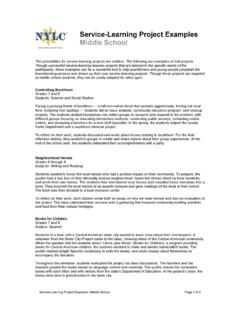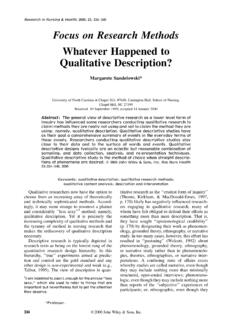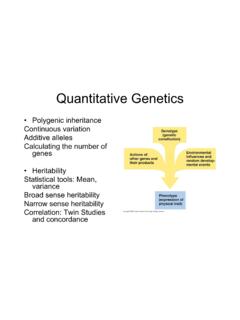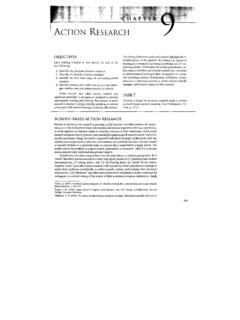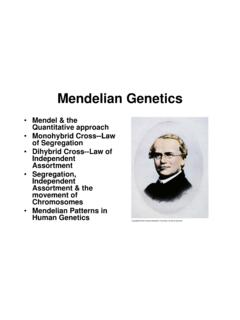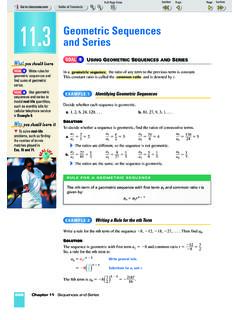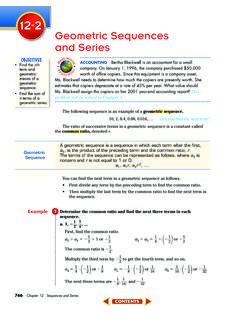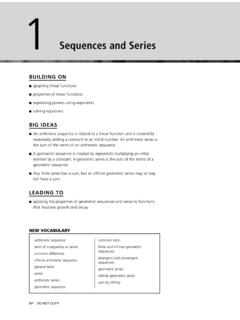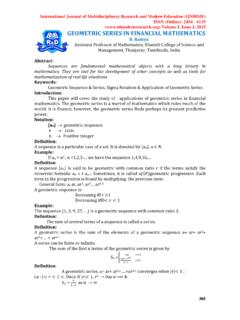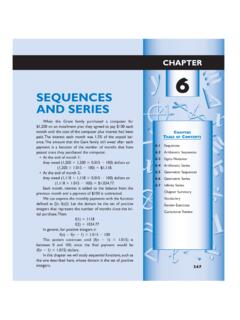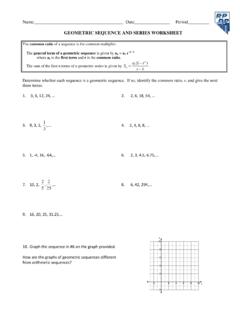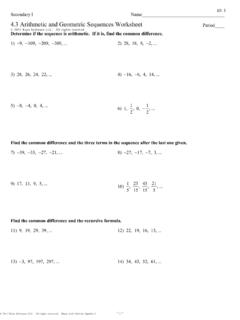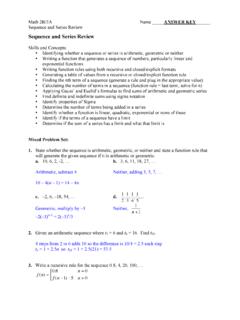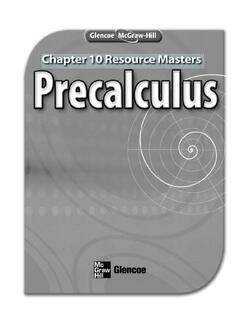Transcription of Calculus III: Sequences and Series Notes (Rigorous Version)
1 Calculus III: Sequences and Series Notes ( rigorous Version). Logic Definition (Proposition) A proposition is a statement which is either true or false. Questions and commands are never propositions, but statements like My Buick is maroon (T) and My Buick is black (F) are propositions. More importantly for the purposes of this course, statements like (an ) converges to ` are propositions, whose truth value you are asked to either find or verify. Definition (Conditional Proposition) A conditional proposition is a proposition of the form If p, then q where p and q are propositions called the hypothesis and conclusion, respectively. We write p q. A conditional proposition is true if it is always true (that is, for every possible instance of a true hypothesis, the conclusion holds true), and false if there is a counterexample. An example of a conditional proposition is If I am at WOU, then I am in Oregon. The hypothesis p is in this case the proposition I am at WOU and the conclusion q is I am in Oregon.
2 Note that for this particular proposition, although p q is true, q p is false. The theorems you use in this course are conditional propositions that are true. Definition (Converse) Let p q be a conditional proposition. The conditional proposition q p is called the converse of p q. As we saw above, a conditional proposition and its converse may have different truth values. Definition (Contrapositive) Let p q be a conditional proposition. The contrapositive form, or simply the contrapositive, of p q is the conditional proposition If not q, then not p and is denoted q p. The contrapositive of If I am at WOU, then I am in Oregon is If I am not in Oregon, then I am not at WOU. If you think about it, you should be able to convince yourself that p q and q p are just two different ways of saying the same thing, and thus must have the same truth values. This is correct, and will have significant value to us in this course. 1. Theorems and Definitions for Sequences Definition ( sequence ; Subsequence) A sequence is a function from the natural numbers N to the real numbers R, and can be thought of as an infinite ordered list of numbers.
3 We denote a sequence by (an ) and the nth term of the sequence (an ) by an . Given a sequence (an ), a subsequence is the same function but whose domain is now an infinite subset of N. A subsequence can be thought of as an infinite sub-list of the infinite list that comprises the original sequence . Note that every sequence is trivially a subsequence of itself. A less trivial example is that n12 can . be interpreted as a subsequence of n1 , where the domain is no longer N, but all natural numbers which are perfect squares. Also, (( 1)n ) is a subsequence of cos n 3 , where the domain has been restricted from N to natural numbers of the form 3n, n N. Definition (Tail) Given a sequence (an ) and a fixed k N, a tail is a particular kind of subsequence of (an ) of the form (an+k ) = (an+k )n N . Definition (Convergence) Let (an ) be a sequence . Then we say that (an ) converges to ` if, no matter how small we choose a positive real number , we can find a N N so that all of the terms in the tail (an+N ) are in the interval (` , ` + ).
4 Note that N will typically be larger for smaller . If (an ) converges to `, we may write either (an ) ` or lim (an ) = `. n . Theorem Const: Let (an ) be a sequence . If an = c R for every n N, then (an ) c. Theorem : If f is a function with lim f (x) = ` R, and if (an ) is a sequence given by an = f (n). x . for each n N, then lim (an ) = `. n . Note that the converse of this theorem is false, because one can't control how the function behaves between the integers.. 1. Theorem : If p > 0, then 0. np . 1. Natural Log Theorem (NLT): If p > 0, then 0. (ln n)p n=2. Limit Laws: Suppose (an ) and (bn ) are convergent Sequences converging to ` and m respectively, and 2. c R. Then (an bn ) ` m (1). (an bn ) `m (2). (can ) c` (3).. an `. provided that bn 6= 0 for all n N, and m 6= 0. (4). bn m The next theorem includes Theorem , but indicates that the converse is true as well. The converse is useful for applying the Test for Divergence, to appear in Theorem (Slightly Improved): Let (an ) be a sequence .
5 If (|an |) 0 then (an ) 0. Also, if (an ) 0 then (|an |) 0. Definition (Boundedness) Let (an ) be a sequence . If there exists M > 0 such that all of the terms of (an ) are in [ M, M ], then we say that (an ) is bounded. Definition (Unboundedness) Let (an ) be a sequence . If no closed interval contains the range of (an ) , then we say that (an ) is unbounded. Recall that we said that if a sequence doesn't converge, the sequence is said to diverge. There are two basic types of divergent Sequences , bounded divergent and unbounded divergent. An example of a bounded divergent sequence is (( 1)n ) , while an example of an unbounded divergent sequence is (n2 ). Our goal is to develop two tools to show that divergent Sequences are in fact divergent. The first will help us show that certain bounded divergent Sequences diverge, while the second will help us show that certain unbounded divergent Sequences diverge. geometric Sequences are a very important type of sequence ; the next theorem regards which geometric Sequences converge.
6 Theorem : Let (crn ) . n=0 be a geometric sequence with c 6= 0. Then .. converges to 0 if |r| < 1.. converges to c if r=1. (crn ).. alternates between c and c and thus diverges boundedly if r = 1.. diverges unboundedly if |r| > 1. 3. The partitioning of divergence into bounded and unbounded categories is useful since it permits us to treat each rigorously. For each type of divergent sequence , a supplementary tool is provided for demonstrating divergence. Subsequence Theorem: If (an ) ` R, then every subsequence of (an ) converges to `. Note that the contrapositive of this is If not every subsequence of converges to `, then (an ) . 6 `. The latter form of the theorem is the most useful one in this course, though the non-contrapositive form is used in Monotonic sequence Theorem problems at the end of Example: To show that (( 1)n ) does not converge, we need only note that the subsequence of (( 1)n ). where n is even is the constant sequence (1) and by Theorem Const converges to 1, while the subse- quence of (( 1)n ) where n is odd is the constant sequence ( 1) and by Theorem Const converges to 1.
7 Thus by the Subsequence Theorem, (( 1)n ) diverges. We'll assume that the following Sequences are known unbounded divergent: (np ) and (ln(n k)p ) for p > 0, k Z and (an ) for a > 1, and any positive constant multiple of any of these Sequences . Push Theorem: Let (an ) be a known unbounded divergent sequence , and (bn ) another sequence . If eventually we have, for some positive constant c, |bn | c an , then (bn ) diverges. Note that this is the divergent analog to the Squeeze Theorem. Example: Suppose we are asked to show that (( 1)n (n3 + 2)) diverges. We need only note that |( 1)n (n3 + 2)| = n3 + 2 n3 , which is a known divergent sequence , so by the Push Theorem, (( 1)n (n3 + 2)) diverges. Continuous Function Theorem (CFT) Let (an ) be a sequence converging to ` R, and let f (x). be a function that is defined on the range of (an ) and which is continuous at `. Then the sequence (f (an )) converges to f (`). Note that another way to state the CFT is that we can pass the limit through the function when the , if (an ) `, if f (an ) is defined for each n N, and if f is continuous above hypotheses are satisfied.
8 At `, then lim (f (an )) = f lim (an ) . n n . A note of interest to those of you who are math majors: The CFT is actually a very good way to define the property of continuity for a function, and is in fact done so in Advanced Calculus . Just so it is clear to which functions the CFT applies, we'll assume the following functions are con- tinuous everywhere ( , on all of R): sin(x), cos(x), ex , xp (p 0), and tan 1 (x). Also, any sum or 4. product of continuous functions is continuous (the quotient case is more complicated). Finally, tan(x).. is continuous at any point not equal to + m , m N, ln(x) is continuous on (0, ), and xp (p < 0). 2. is continuous on R \ {0}.. (2n + 1) . Example: For example, to show that sin 1, we first consider the argument 4n (2n + 1) (2 + n1 ) 2 + n1. = = . 4n 4 4.. 1. We know that converges to zero, since it is a p- sequence with p = 1 > 0. Thus by LL2, n 1. 0 = 0. By Theorem Const, (2 ) 2 and (4) 4. Thus, by LL1 and LL4, n ! 2 + n1.. (2n + 1) 2 + 0.
9 = = . 4n 4 4 2.. (2n + 1) . Finally, by the CFT, sin sin = 1. 4n 2. Theorem (Decreasing Sequences by Derivative - DSBD) Let (an ) be a sequence , and f a func- tion such that f (n) = an for all n N. If for some x0 1, we have f 0 (x) < 0 for all x > x0 , then (an ). is decreasing for all n > x0 (this means that (an ) is eventually decreasing).1. Theorem (Log-Monomial-Exponential - LME) For all p, q, r, c1 , c2 , c3 > 0 and for all x larger than some x0 depending on the constants p, q, r, c1 , c2 , c3 we have c1 (ln x)p < c2 xq < c3 erx . Theorem (Equal Sequences , Equal Limits - ESEL) If (an ) and (bn ) are Sequences such that an = bn eventually and (an ) `, then (bn ) `. Using l'H . opitals's Rule for Sequences The following algorithm is useful for the solutions of these problems, so we'll follow it for each such problem: 1. Identify the sequence formula as an indeterminate (if it is not an indeterminate form, you won't use l'H opital's Rule).. 1 ln n Theorem DSBD is useful for showing that for example is decreasing, in order to use the Alternating Series n.
10 X ln n Test (which will appear a bit later on in the course) on ( 1)n . n=2. n 5. 2. If necessary, algebraically rearrange the sequence into the indeterminate form 0. or 0 . For some problems (typically where n is present in both the base and the exponent), this may require taking the natural logarithm, so be prepared to invoke the CFT at the end of the problem. 3. In anticipation of using l'H . opital's Rule, create the function formula for f (x) from the sequence formula for an by substituting x for n. 4. Differentiate the numerator and denominator separately (no quotient rule!) and find the limit as x of the resulting function, if possible. (a) Repeat Step 4 as many times as necessary until a finite limit is found, if possible. 5. Write the conclusion of l'H . opital's Rule in the correct order. It will appear something like this: 1/x l0 H ln x 0 = lim = lim . x 1 x x 6. Invoke the Asymptote Theorem (Theorem ). 7. If necessary, algebraically undo Step 2 and invoke the CFT to find the original limit.

